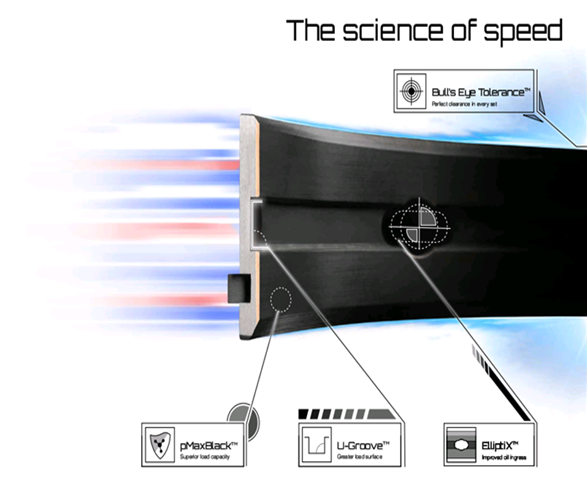Main page
About us
Sliding Bearings Consulting
Advertising Opportunities

SubsTech’s sister website Smooth Sliding provides independent engineering consulting services that help you to solve engine bearing related issues: failures, material selection, geometry design and optimization of hydrodynamic conditions.
Smooth Sliding is an engineering consulting company run by Dr. Dmitri Kopeliovich:
- VP R&D of King Engine Bearings.
- World leading expert (32 years of experience) in design, technology and materials for Engine bearings in applications such as automotive, renewable energy, aviation, racing and others.
- Founder and owner of SubsTech (Substances & Technologies) – a leading professional website on Materials Science and Engineering.
- Author of numerous scientific and engineering publications and patents.
- Founder and owner of Smooth Sliding.
For further information and for requesting consulting services please visit our sister website Smooth Sliding.
to Metals
to Engine bearings
Bearing Materials For Race Engines
Introduction
Operating conditions of race engines differ from those of street engines. Here are the main differences:
- Higher rotation speeds
- Higher cylinder pressure produced by greater compression ratio or by more intensive turbo aspiration
- Low viscosity oils which reduce power losses caused by friction
Consequently, bearings in race engines work at greater specific bearing loading and with lower oil film thickness. The actual lubrication regime of race bearings is not hydrodynamic [1]. Materials for race bearings are developed with the objective of reducing the risks of fatigue, abnormally fast wear, and seizure.
to top
Bi-metal Race Bearings
Most aluminum alloys used in bi-metal bearings have a load capacity below 10,000 psi. Therefore, they cannot be used in engines combining high loads and relatively long service life. However, some features of aluminum bi-metal bearings have clear advantages over tri-metal.
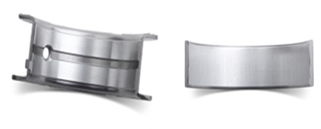
Fig.1 King HP bi-metal bearings
First of all, they do not have an overlay. Since the working layer of bi-metal bearings is relatively thick, they are very tolerant of housing and journal geometric defects and to the condition of continuous metal-to-metal contact (characteristic of drag racing). With bi-metal bearings, the critical amount of tolerable wear is considerably greater than that of tri-metal bearings with their thin overlay. King Engine Bearings has developed high performance bi-metal aluminum alloy bearings (product suffix HP) containing tin as a solid lubricant and silicon particles to enhance seizure resistance and load capacity. HP bearings are best suited for street, all out drag racing, monster truck and medium loaded circle track race engines. The aluminum alloy of HP bearings provides a balanced combination of good load capacity with good embedability and conformability - characteristics for absorbing debris and conforming to crankshaft misalignments and deflection. Compatibility of the alloy is further improved by the presence of silicon particles distributed throughout the composition. Silicon helps to prevent seizure in the event of a mixed lubrication regime, and serves to prevent excessive bearing wear by diminishing and polishing smooth any ferrite peaks that may be present on the surface of a nodular cast iron crankshaft.
to top
pMax Black™: Strengthened Tri-metal Bearing Material
Tri-metal bearings with soft leaded overlays are traditionally popular in racing applications. Since engine efficiency and output have increased considerably over the last years, specific loads applied to the bearings have also increased. In addition to greater loading, there is also a trend to use reduced viscosity motor oils which lower the power losses caused by friction. As a result, bearings in modern race engines work at higher loads and with lower minimum oil film thicknesses. The load capacity and Wear resistance of traditional tri-metal materials may be inadequate for some high performance applications. King Engine Bearings has solved this problem with its strengthened tri-metal material, pMax Black™ (Fig. 2), specifically developed for highly loaded race engines. This development comprises an innovative technique that enables the formation of an ultra-thin hardened shield on the overlay surface. This shield, of nano-scale thickness, considerably reduces overlay wear. It also effectively suppresses the formation of fatigue cracks on the overlay surface. pMax Black™ bearings withstand greater loads without the formation of fatigue cracks and distress. Experiments using King’s test rig have demonstrated that the fatigue resistance of pMax Black™ overlay is 10,200 psi. This is 17% greater than that of conventional tri-metal bearings (8700 psi). At the same time, the properties of excellent seizure resistance, conformability and embedability – which are characteristics of soft overlays – are preserved. All King XP series high performance bearings are manufactured with this hardened pMax Black™ overlay. These bearings are easily recognizable by their distinctive dark color.
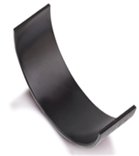
Fig. 2 King pMax Black™ bearings
It is important to emphasize that the pMax Black™ overlay, with its nano-scale hardened layer, is still much softer than steel or cast iron. Therefore it is completely compatible and produces no damage to the journal surface.
pMax Black™ bearings have been tested and compared to identical bearings made with conventional tri-metal high performance material offered by three bearing manufacturers. The tests were performed in the King Test Rig [2]. Test conditions: Load: 10,150 psi, Duration: 24 hrs. The condition of the bearings after the tests is depicted in Fig. 3.
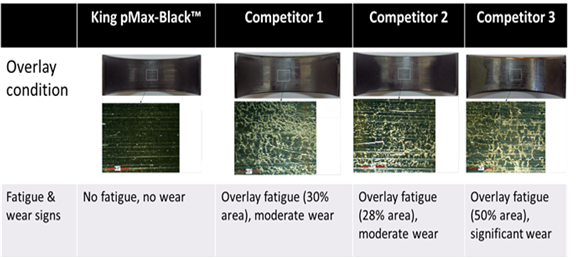
Fig. 3 Fatigue test of King pMax Black™ vs. competitor materials
The pMax Black™ bearing survived the test without overlay fatigue nor any noticeable signs of wear. A substantial area (between 28 to 50%) of the overlays on competitor bearings was compromised by fatigue cracks and wear.
to top
SV Material For Extreme Load
The load applied to bearings in some diesel and boosted gasoline high performance engines may exceed 10,200 psi. The bearings, particularly the upper rod shells, should be made from materials that are even stronger than pMax Black™. For such applications, King has developed bearings made of a strong intermediate layer of copper-bismuth alloy and a high strength silver overlay (product suffix SV). The fatigue resistance of these bearings is 17,400 psi. The silver overlay pairs extremely high fatigue strength and wear resistance with good seizure resistance.
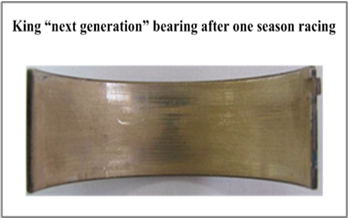
Fig.4 SV bearing after one season of racing
Surface anti-friction properties of SV bearings are improved by applying an additional layer of either Babbitt or polymer coating.
to top
Polymer Coatings for Race Bearings
Due to continuous developments in the design of internal combustion engines, the typical minimum values of oil film are getting smaller and smaller. In addition, very high loads may cause metal-to-metal contact between bearing and shaft. Such contact requires a bearing material with superior anti friction properties. Lack of liquid lubricant (oil) during mixed lubrication [3] may be compensated by a bearing surface consisting of a polymer matrix. Containing Solid lubricants distributed in the form of fine particles, this polymer matrix can be applied as a coating to existing bearings to serve as the top layer. Such coatings may also contain particles of reinforcing phase added for greater strength and Wear resistance. Similar to oil film, a polymer coating separates the metallic bearing material from the crankshaft surface. Therefore, in the system of bearing/lubricant/journal, the polymer coating may be referred to as either lubricant or bearing material.
Proceeding in this manner, there are two possible concepts of polymer coatings:
A. A temporary sacrificial layer of lubricant wearing off in the bearing conforming process
B. A permanent bearing overlay maintained for the entire bearing service life
Polymer coatings developed by King Engine Bearings are composed of different types of inorganic and ceramic additives dispersed in a polymer matrix. The additives have nano-dimensions. Thus, the coating material may be defined as a polymer ceramic nano-composite.
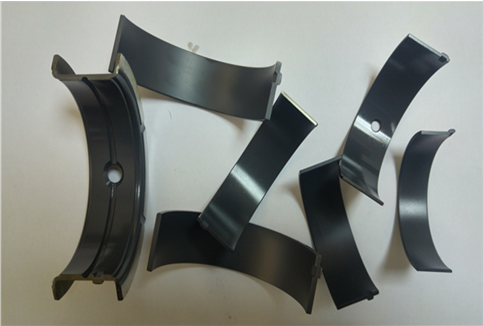
Fig.5 Polymer coated King race bearings
Three different types of polymer coatings for different applications have been developed by King Engine Bearings: K-334, K-340 and K-40. K-334, known as pMax Kote™, is already available in the aftermarket from King.
K-334 (pMax Kote™)
K-334 is a wear resistant coating for applying over relatively soft substrate. It is not sacrificial. K-334 was developed for coating tri-metal pMax Black™ XP high performance bearings. The coating helps to improve XP bearing wear resistance under conditions of metal-to-metal contact. It also increases resistance to cavitation erosion. In contrast to other coated bearing manufacturers and suppliers, King pMax Kote™ does not affect oil clearance. The wall thickness of these King coated bearings is equal to that of non-coated King bearings. A performance comparison of polymer coated tri-metal race bearings, from four leading bearing manufacturers/suppliers, under the regime of metal-to-metal contact is presented in Fig.6.
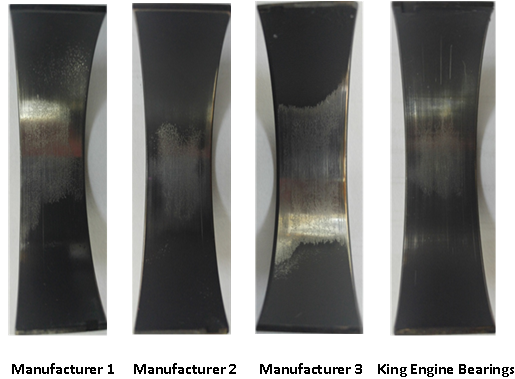
Fig.6 Bearings tested in King Test Rig in mixed lubrication regime at 10,150 psi for 24 hrs.
Two conclusions can be made from the tests:
- The wear rate of King K-334 coating (pMax Kote™) is the least of the four tested manufacturers
- The fatigue strength of King pMax Black™ XP bearings is greater than that of competitive materials, which have clear fatigue cracks in the overlay
K-340
K-340 is a strong coating, offering exceptional wear resistance, toughness and fatigue strength. It was designed for applying over relatively hard substrates: bronze, aluminum alloys, sputter overlay, and King silver overlay. Hardness of the coating is about 46 HV, which is harder than most aluminum bearing alloys. The coating is able to operate under loads up to 17,400 psi (120 MPa) in diesel direct injection engines, turbocharged gasoline engines, race engines, start-stop and hybrid engines, and in conventional passenger car engines replacing Babbitt plated tri-metal bearings. K-340 coated bearings tested at 11,600 psi (80 MPa) for 24 hrs. are depicted in Fig.7.
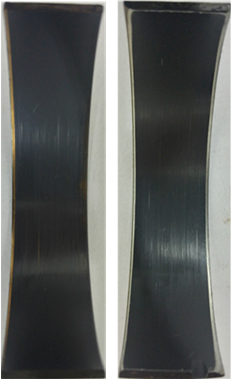
Fig.7 Tested bearings coated with K-340 wear resistant coating
(left – steel-bronze bearing, right – steel aluminum bearing)
The bearings retained their coating after the test, proving the outstanding wear resistance of K-340 material.
K-40
K-40 is a relatively soft coating. It is sacrificial by design, with excellent conformability and anti-friction properties. K-40 was designed specially for engines experiencing continuous metal-to-metal contact. This is characteristic of the extreme loading and conditions found in drag racing. The image of a bearing tested under continuous direct contact with the journal is depicted in Fig.8.
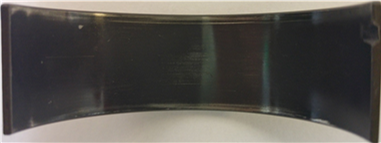
Fig.8 King aluminum alloy HP bearing coated with K-40 after direct friction test
The bearing appearance proves the ability of K-40 to withstand the conditions of direct friction.
to top
Conclusions
- Bi-metal HP material, aluminum alloy containing silicon, has been developed by King Engine Bearings for medium load race engines and for engine bearings working in continuous or prevalent metal-to-metal contact (drag racing, monster truck).
- It was proven that pMax Black™ XP race bearings have 17% greater load capacity than conventional tri-metal high performance materials.
- SV bearings, with silver alloy overlay, provide extremely high load capacity up to 17,400 psi and good seizure and wear resistance.
- King coatings are polymer ceramic nano-composites combining lubrication properties with excellent wear resistance, toughness, fatigue strength and cavitation resistance.
- K-334 (pMax Kote™) coated King tri-metal pMax Black™ race bearings demonstrated superior wear resistance and fatigue strength among bearings from four leading manufacturers/suppliers
- K-340 is a non-sacrifical coating designed for application directly onto relatively hard substrate: bronze or aluminum intermediate layers, sputter or silver overlays
- K-40 is the softest King coating, sacrificial by design. It has demonstrated exceptional ability to work under continuous direct friction conditions, typical as may be found in certain types of drag racing.
References
- [1] Dudley D. Fuller (1958), A Survey of Journal Bearing Literature, Amer. Soc. of Lubricating Engineers
- [2] Dmitri Kopeliovich, “Engine bearing fatigue test”, SubsTech (Substances&Technologies), Available from www.substech.com/dokuwiki/doku.php?id=engine_bearing_fatigue_test
- [3] Dmitri Kopeliovich, “Lubrication regimes” SubsTech (Substances & Technologies). Retrieved from www.substech.com/dokuwiki/doku.php?id=lubrication_regimes
Related internal links
to Metals
to Engine bearings



